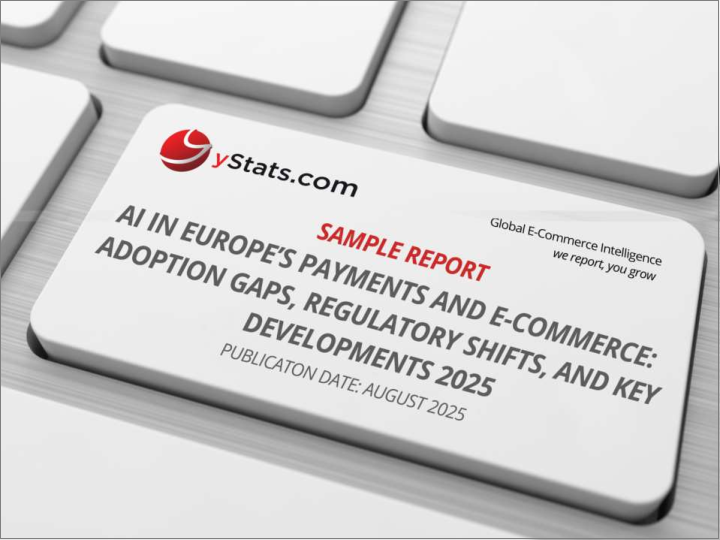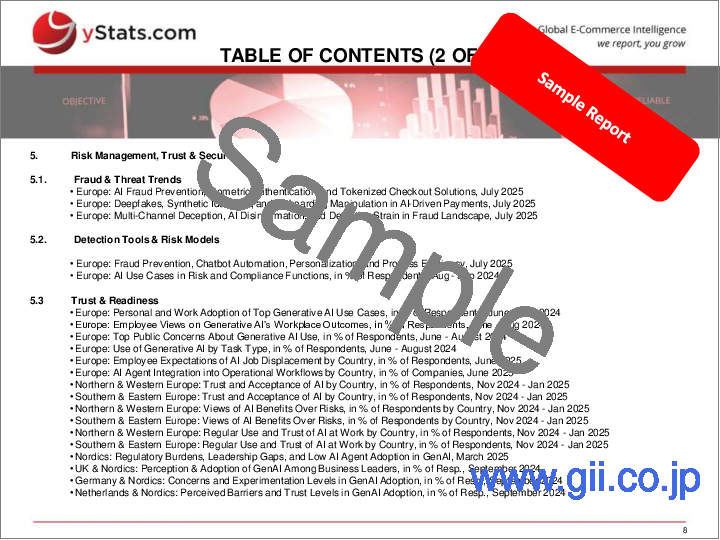|
|
市場調査レポート
商品コード
1780253
欧州の決済およびEコマースにおけるAI:導入のギャップ、規制の変化、2025年の主な展開AI in Europe's Payments and E-Commerce: Adoption Gaps, Regulatory Shifts, and Key Developments 2025 |
||||||
|
|||||||
| 欧州の決済およびEコマースにおけるAI:導入のギャップ、規制の変化、2025年の主な展開 |
|
出版日: 2025年07月29日
発行: yStats.com
ページ情報: 英文 81 Pages
納期: 即日から翌営業日
|
全表示
- 概要
- 目次
欧州の決済とEコマースにおけるAI導入が加速。しかし信頼、人材、統合には依然としてギャップが存在、とyStats.comが指摘
北欧と東欧がAI活用でリードするも、統合のギャップは依然残る
欧州全体でAI導入が勢いを増しており、特にバルト三国や北欧諸国では企業のAI活用が活発です。ラトビア、ノルウェー、エストニアなどがその代表であり、ポーランドやスロベニアも地域平均を上回るスピードで導入を進めています。一方で、ドイツ、フランス、オランダといった主要経済国ではその進展が鈍く、スペインに至っては業務への統合がほとんど見られない状況です。実験的な導入は広く行われているものの、業務運用レベルでの成熟にはまだ多くの企業が到達していません。
欧州の新しいAI法が「勝者」と「敗者」を生む
EU AI法(EU AI Act)、DORA(デジタル業務レジリエンス法)、GDPR(一般データ保護規則)の三者が交差することで、規制対応力が差別化要因となってきています。本レポートによれば、これらの規制への準拠をAI戦略に組み込んでいる企業は、詐欺検出や信用スコアリングといった高リスク領域で構造的な優位性を得ています。一方で、パイロットを超える運用に失敗した企業は、取り残されるリスクがあります。
信頼の欠如が金融サービス分野におけるAIの可能性を阻む
AIの進展に対して、一般の懐疑的な見方は根強く残っています。欧州の多くの国々では、利用者の半数未満しか「AIの利点がリスクを上回る」と考えておらず、とりわけ北欧および西欧ではその傾向が顕著です。ディープフェイクやフィッシングといったAI駆動型の詐欺手口が広がることで、信頼はさらに損なわれています。yStats.comのCEOであるユセル・イェルケン氏はこう警鐘を鳴らしています。「信頼、人材、インフラの強化がなければ、ヨーロッパのAI推進は“規制対応止まり”で失速しかねません。」
当レポートでは、欧州の決済およびEコマースにおけるAIの動向を調査し、地域全体および主要国別のAI導入状況 、AIの導入事例、リスク管理・信頼・セキュリティに関する動向、競合情勢、主要国別の詳細分析などをまとめています。
目次
第1章 マネジメントサマリー
第2章 重要ポイント
第3章 AI導入の情勢と地域パターン
- 地域別採用ベンチマーク
- 北欧・西欧:国別AI導入状況 (定期的に利用していると回答した人の割合)
- 南欧・東欧:国別AI導入状況 (定期的に利用していると回答した人の割合)
- 欧州:従業員10人以上の企業におけるAI技術導入率:国別
- 欧州:従業員10人以上の企業におけるAIアプリケーションタイプの割合
- 欧州:国別の従業員のAIツール利用状況 (週に数回AIを使用している回答者の割合)
- 販売者のセグメンテーションと障壁
- 欧州:生成AI導入の遅れ、IT投資不足、インフラの限界
- 欧州:AI再教育目標、人材維持の問題、コンプライアンス上の障壁
第4章 機能的なユースケースと経済的影響
- Eコマース販売者業務
- 欧州:LVMHのデザイン、Eコマース、エンゲージメント、オペレーションにおけるAI統合
- 欧州:LVMHのEコマース検索、ロイヤルティプログラム、販売ツールにおけるAIの活用
- 決済とフィンテックのユースケース
- 欧州:AIを活用した決済自動化、不正検知、コアインフラのアップグレード
- 欧州:リスク管理、バリューサービス、インフラ効率化のためのオープンバンキングにおけるAI
- 欧州:AIウォレットの統合、P2Pの拡大、デジタルユーロの統合
- 欧州:AI主導のMCAの成長、PSPの統合、PSD3別規制の整合
- 欧州:デジタルユーロ、MiCA規制、イノベーションフレームワーク、AI主導型決済
第5章 リスク管理、信頼とセキュリティ
- 詐欺と脅威の動向
- 欧州:AIによる不正防止、生体認証、トークン化されたチェックアウトソリューション
- 欧州:AI主導型決済におけるディープフェイク、合成ID、オンボーディング操作
- 欧州:マルチチャネルによる欺瞞、AIによる偽情報、不正行為の情勢における負担
- 検出ツールとリスクモデル
- 欧州:不正防止、チャットボット自動化、パーソナライゼーション、プロセス効率
- 欧州:リスクおよびコンプライアンス機能におけるAIの活用事例 (回答者の割合)
- 信頼と準備
- 欧州:個人および職場における主要な生成AIユースケースの導入状況 (回答者の割合)
- 欧州:生成AIの職場における成果に関する従業員の見解 (回答者の割合)
- 欧州:生成AIの利用に関する国民の主な懸念事項 (回答者の割合)
- 欧州:タスクタイプ別の生成AIの利用状況 (回答者の割合)
- 欧州:AIによる雇用喪失に関する従業員の予想:国別 (回答者の割合、2025年6月)
- 欧州:運用ワークフローへのAIエージェント統合企業の割合:国別 (2025年6月)
- 北欧・西欧:AIへの信頼と受容度 (国別、回答者の割合)
- 南欧・東欧:AIへの信頼と受容度 (国別、回答者の割合)
- 北欧・西欧:AIのリスクに対するメリットの見解 (国別回答者の割合)
- 南欧・東欧:AIのリスクに対するメリットの認識 (国別回答者の割合 )
- 北欧・西欧:職場におけるAIの定期的利用と信頼度 (国別、回答者の割合)
- 南欧・東欧:職場におけるAIの定期的利用と信頼度 (国別、回答者の割合)
- 北欧諸国:規制負担、リーダーシップギャップ、生成AIにおけるAIエージェントの低い導入率
- 英国・北欧:ビジネスリーダーにおける生成AIの認識と採用率 (回答者の割合)
- ドイツ・北欧:生成AI導入に関する懸念と実験レベル (回答者の割合)
- オランダ・北欧諸国:生成AI導入における障壁と信頼度 (回答者の割合)
- 規制とコンプライアンス
- 北欧・西欧:AI規制の必要性を指摘する回答者の割合:国別
- 南欧・東欧:AI規制の必要性を指摘する回答者の割合:国別
- 欧州:説明責任のギャップ、データの偏り、操作によるGPAI主導の消費者リスク
- 欧州:AI統合における制度的、規制的、技術的障害
- 欧州:GPAIの説明可能性の限界、ICTリスク、銀行業界における人材不足
- 欧州:AIの透明性、第三者監視、ICTリスク、倫理的使用要件
- 欧州:AI法リスクモデル、eコマースの導入、AI協定別早期導入
第6章 競合情勢と戦略的AIの動き
- 市場規模と活動
- 欧州:AI世代の生産性向上、モデルの不足、インフラのギャップ、エネルギー需要
- 欧州:AI半導体設計、クラウドインフラ、原材料供給
- 主要企業の戦略的動き
- 欧州:資金調達、規制、イノベーションを通じたAIガバナンスの推進
- 欧州:クラウド依存、モジュラーAIアーキテクチャ、戦略的投資の優先順位
- AIガバナンス、規制、イノベーション促進要因
- 欧州:AI法、規制サンドボックス、テスト環境、データ空間戦略
第7章 国別スポットライト:国の洞察と戦略的課題
- 英国
- ディープフェイク詐欺、フィンテックの脆弱性、AIを用いた詐欺における取り締まりの不備
- AI駆動型企業詐欺における経営幹部のなりすましと国境を越えたリスク
- ドイツ
- 生成AI導入によるメリット (回答者の割合)
- 生成AI導入における主な障壁 (回答者の割合)
- 企業における生成AI戦略の実施状況 (回答者の割合)
- 企業における信頼できるAI導入の最大の障壁 (回答者の割合)
- デジタルシステムにおける電子犯罪の脅威ベクトル (回答者の割合)
- フランス
- 生成AIの信頼性、規制の明確化、人材ギャップ、インフラの限界
- 生成AI導入の主な阻害要因と世界基準値の比較
- スペイン
- 技術投資と戦略的デジタル変革への企業の注力度 (回答者の割合)
- AI導入における構造的障壁、中小企業の制約、断片化されたデジタル戦略
- ポーランド
- AI投資への認識:企業規模別 (回答者の割合)
- 制度的ギャップ、中小企業の抵抗、競争力におけるAIの障壁
AI Adoption Accelerates Across European Payments and E-Commerce, but Gaps in Trust, Talent, and Integration Persist, yStats.com Finds
Northern and Eastern Europe Take the Lead in AI Use, but Integration Gaps Persist
AI adoption is gaining traction across Europe, especially in the Baltics and Nordics, where enterprise usage is high in countries like Latvia, Norway, and Estonia. Poland and Slovenia are also accelerating ahead of the regional average. Yet, major economies such as Germany, France, and the Netherlands show slower momentum, while Spain trails with minimal integration into workflows. Despite widespread experimentation, true operational maturity remains out of reach for many firms.
Europe's New AI Laws Create Winners and Losers
With the EU AI Act, DORA, and GDPR converging, regulatory alignment is becoming a key differentiator. The report finds that firms incorporating compliance into their AI strategies gain a structural advantage in high-risk areas like fraud detection and credit scoring. Those that fail to operationalize beyond pilots risk being left behind.
Trust Deficit Undermines AI's Promise in Financial Services
Public skepticism continues to shadow AI advances. In most European countries, fewer than half of users believe the benefits outweigh the risks, with especially low trust in Northern and Western Europe. Growing exposure to AI-driven fraud tactics like deepfakes and phishing further erodes confidence. As yStats.com CEO Yucel Yelken warns, "Without stronger trust, talent, and infrastructure, Europe's AI momentum may stall at the compliance layer."
Table of Contents
1. Management Summary
2. Key Takeaways
3. AI Adoption Landscape & Regional Patterns
- 3.1. Regional Adoption Benchmarks
- Northern & Western Europe: Adoption of AI by Country, in % of Respondents Reporting Regular Use, Nov 2024 - Jan 2025
- Southern & Eastern Europe: Adoption of AI by Country, in % of Respondents Reporting Regular Use, Nov 2024 - Jan 2025
- Europe: AI Technology Adoption by Country, in % of Enterprises with 10 or More Employees, 2023 & 2024
- Europe: AI Application Types, in % of Enterprises with 10 or More Employees, 2023 & 2024
- Europe: Employee Usage of AI Tool by Country, in % of Respondents Using AI Several Times Weekly, June 2025
- 3.2. Seller Segmentation & Barriers
- Europe: Lag in Generative AI Adoption, IT Investment Deficit, and Infrastructure Limitations, July 2025
- Europe: AI Reskilling Targets, Talent Retention Issues, and Compliance Barriers, July 2025
4. Functional Use Cases & Economic Impact
- 4.1. E-Commerce Seller Operations
- Europe: LVMH's AI Integration Across Design, E-Commerce, Engagement, and Operations, July 2025
- Europe: AI Use in LVMH's E-Commerce Search, Loyalty Programs, and Sales Tools, July 2025
- 4.2. Payments & FinTech Use Cases
- Europe: AI-Driven Payment Automation, Fraud Detection, and Core Infrastructure Upgrades, July 2025
- Europe: AI in Open Banking for Risk Control, Value Services, and Infrastructure Efficiency, July 2025
- Europe: AI Wallet Mergers, P2P Expansion, and Digital Euro Integration, July 2025
- Europe: AI-Driven MCA Growth, PSP Consolidation, and Regulatory Alignment via PSD3, July 2025
- Europe: Digital Euro, MiCA Regulation, Innovation Framework, and AI-Driven Payments, July 2025
5. Risk Management, Trust & Security
- 5.1. Fraud & Threat Trends
- Europe: AI Fraud Prevention, Biometric Authentication, and Tokenized Checkout Solutions, July 2025
- Europe: Deepfakes, Synthetic Identities, and Onboarding Manipulation in AI-Driven Payments, July 2025
- Europe: Multi-Channel Deception, AI Disinformation, and Detection Strain in Fraud Landscape, July 2025
- 5.2. Detection Tools & Risk Models
- Europe: Fraud Prevention, Chatbot Automation, Personalization, and Process Efficiency, July 2025
- Europe: AI Use Cases in Risk and Compliance Functions, in % of Respondents, Aug - Sep 2024
- 5.3 Trust & Readiness
- Europe: Personal and Work Adoption of Top Generative AI Use Cases, in % of Respondents, June - Aug 2024
- Europe: Employee Views on Generative AI's Workplace Outcomes, in % of Respondents, June - Aug 2024
- Europe: Top Public Concerns About Generative AI Use, in % of Respondents, June - August 2024
- Europe: Use of Generative AI by Task Type, in % of Respondents, June - August 2024
- Europe: Employee Expectations of AI Job Displacement by Country, in % of Respondents, June 2025
- Europe: AI Agent Integration into Operational Workflows by Country, in % of Companies, June 2025
- Northern & Western Europe: Trust and Acceptance of AI by Country, in % of Respondents, Nov 2024 - Jan 2025
- Southern & Eastern Europe: Trust and Acceptance of AI by Country, in % of Respondents, Nov 2024 - Jan 2025
- Northern & Western Europe: Views of AI Benefits Over Risks, in % of Respondents by Country, Nov 2024 - Jan 2025
- Southern & Eastern Europe: Views of AI Benefits Over Risks, in % of Respondents by Country, Nov 2024 - Jan 2025
- Northern & Western Europe: Regular Use and Trust of AI at Work by Country, in % of Respondents, Nov 2024 - Jan 2025
- Southern & Eastern Europe: Regular Use and Trust of AI at Work by Country, in % of Respondents, Nov 2024 - Jan 2025
- Nordics: Regulatory Burdens, Leadership Gaps, and Low AI Agent Adoption in GenAI, March 2025
- UK & Nordics: Perception & Adoption of GenAI Among Business Leaders, in % of Resp., September 2024
- Germany & Nordics: Concerns and Experimentation Levels in GenAI Adoption, in % of Resp., September 2024
- Netherlands & Nordics: Perceived Barriers and Trust Levels in GenAI Adoption, in % of Resp., September 2024
- 5.4. Regulation & Compliance
- Northern & Western Europe: Share Citing a Need for AI Regulation by Country, in % of Respondents Nov 2024 - Jan 2025
- Southern & Eastern Europe: Share Citing a Need for AI Regulation by Country, in % of Respondents Nov 2024 - Jan 2025
- Europe: GPAI-Driven Consumer Risks from Accountability Gaps, Data Bias, and Manipulation, July 2025
- Europe: Institutional, Regulatory, and Technical Obstacles to AI Integration, July 2025
- Europe: GPAI Explainability Limits, ICT Risks, and Talent Shortages in Banking Sector, July 2025
- Europe: AI Transparency, Third-Party Oversight, ICT Risk , and Ethical Use Requirements, July 2025
- Europe: AI Act Risk Model, E-Commerce Adoption, and Early Implementation via AI Pact, July 2025
6. Competitive Landscape & Strategic AI Movement
- 6.1. Market Scale & Activity
- Europe: Gen AI Productivity Gains, Model Deficit, Infrastructure Gaps, and Energy Demand, July 2025
- Europe: AI Semiconductor Design, Cloud Infrastructure, Raw Material Supply, July 2025
- 6.2. Strategic Moves by Key Players
- Europe: Advancing AI Governance Through Funding, Regulation, and Innovation, July 2025
- Europe: Cloud Dependency, Modular AI Architecture, and Strategic Investment Priorities, July 2025
- 6.3 AI Governance, Regulation & Innovation Enablers
- Europe: AI Act, Regulatory Sandboxes, Testing Environments, and Data Space Strategy, July 2025
7. Country Spotlights: National Insights & Strategic Challenges
- 7.1. UK
- Deepfake Scams, Fintech Vulnerabilities, and Enforcement Gaps in AI-Driven Fraud, July 2025
- Executive Impersonation and Cross-Border Risks in AI-Driven Corporate Fraud, July 2025
- 7.2. Germany
- Top-Reported Benefits of GenAI Adoption, in % of Respondents, March 2025
- Top-Reported Barriers of GenAI Adoption, in % of Respondents, March 2025
- GenAI Strategy Implementation Status Among Enterprises, in % of Respondents, 2024 & 2025
- Top Barriers to Trusted AI Implementation Among Enterprises, in % of Respondents, March 2025
- eCrime Threat Vectors in Digital Systems, in % of Respondents, May 2024
- 7.3. France
- GenAI Confidence, Regulatory Clarity, Talent Gaps, and Infrastructure Limitations, July 2025
- Top GenAI Adoption Inhibitors vs. Global Baseline, in % Point Difference, January 2025
- 7.4. Spain
- Company Focus on Tech Investment and Strategic Digital Transformation, in % of Respondents, July 2025
- Structural Barriers to AI Adoption, SME Limitations, and Fragmented Digital Strategy, July 2025
- 7.5. Poland
- Poland: AI Investment Perception by Company Size, in % of Respondents, June 2025
- Poland: Institutional Gaps, SME Resistance, and AI Barriers in Competitiveness Context, July 2025






